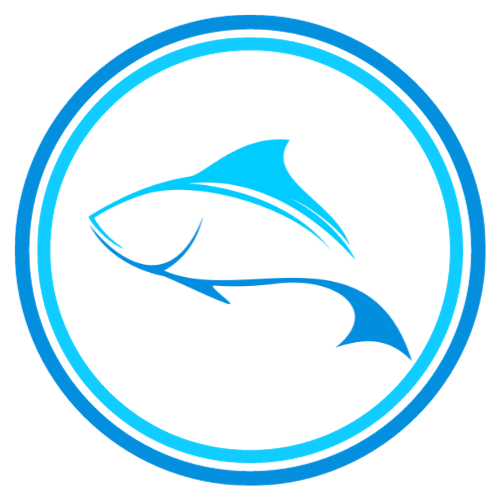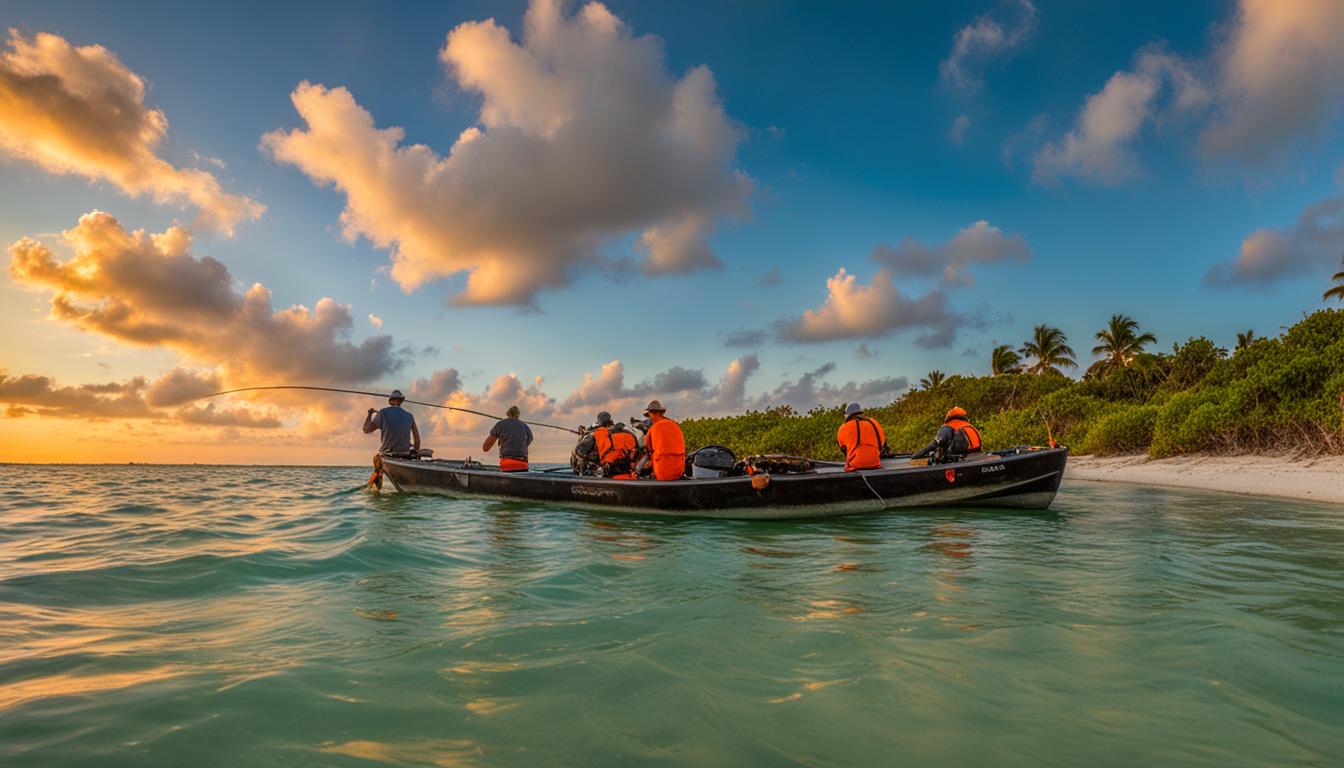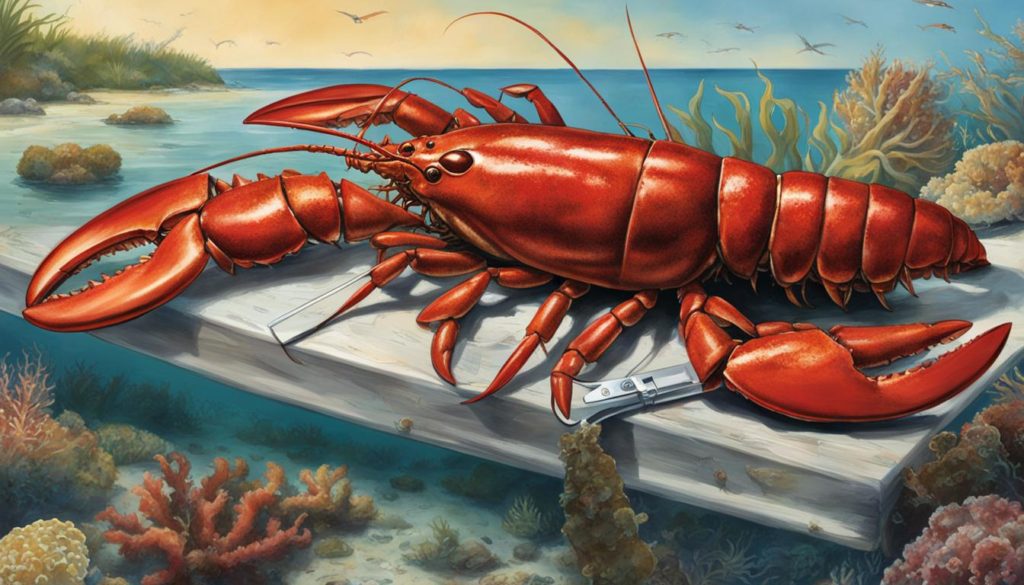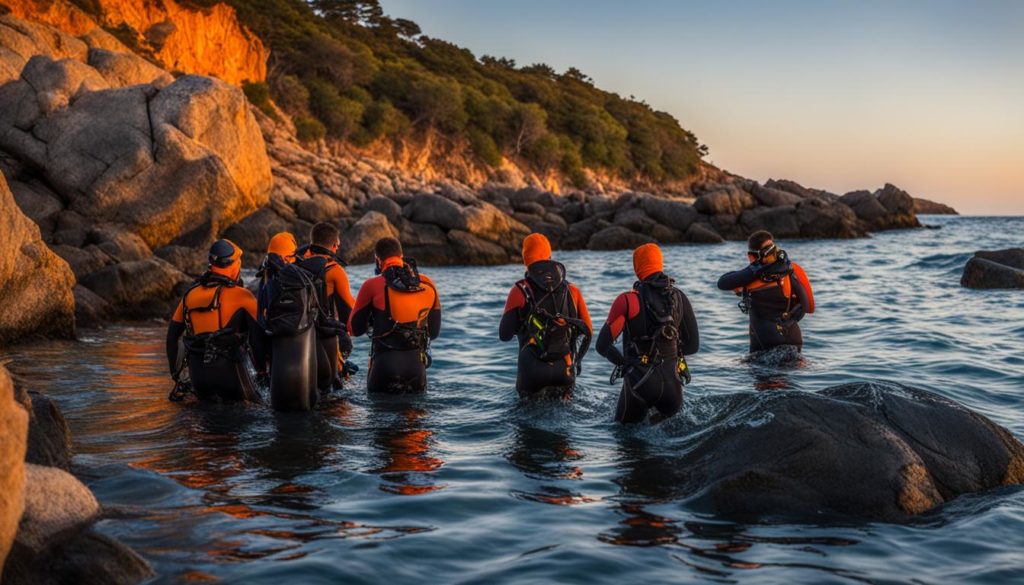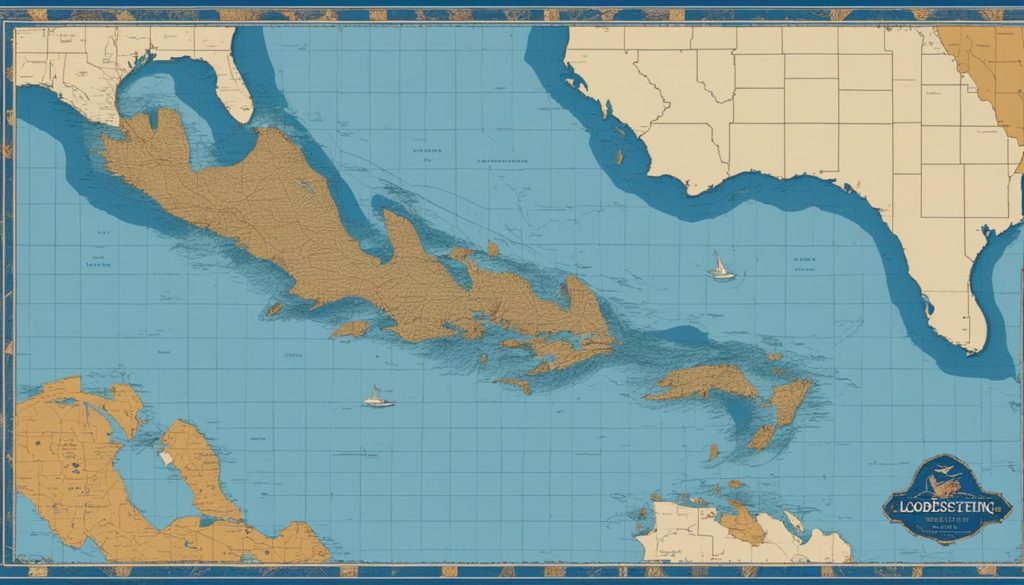Welcome to the Ultimate Guide to Lobstering in Florida! If you’re interested in exploring the fascinating world of lobstering, Florida is the perfect destination. With its diverse lobster species, breathtaking underwater landscapes, and clear, warm waters, Florida offers a unique and exciting lobstering experience for both beginners and experienced enthusiasts. In this comprehensive guide, we will cover everything you need to know about how to go lobstering in Florida, including lobstering regulations, the best spots for lobstering, lobster catching techniques, equipment and gear, Florida lobstering tips, legal size limits, and obtaining the necessary licenses. So, get ready to dive in and discover the exhilarating world of lobstering in Florida!
Key Takeaways:
- Learn how to go lobstering in Florida with this ultimate guide
- Discover the best spots for lobstering in Florida
- Understand the lobstering regulations and legal size limits in Florida
- Master lobster catching techniques and ensure you have the right equipment and gear
- Get valuable Florida lobstering tips to enhance your lobstering experience
Best Spots for Lobstering in Florida
When it comes to lobstering in Florida, there are several standout locations that offer the best opportunities for a successful catch. These spots are known for their diverse habitats and abundant lobster populations, making them a favorite among lobstering enthusiasts. Whether you’re a local or visiting Florida, these top spots should be on your lobstering bucket list.
1. Key West
If you’re looking for the ultimate lobstering experience, Key West is the place to be. This vibrant city located in the Florida Keys is renowned for its rich marine life and thriving lobster populations. During lobster season, Key West becomes a hub of excitement as locals and visitors dive into the waters in search of these delectable creatures. The pristine reefs and rocky ledges of Key West provide the perfect habitat for lobsters to thrive, ensuring a fruitful lobstering adventure.
2. Dry Tortugas National Park
Located approximately 70 miles west of Key West, Dry Tortugas National Park is a remote and pristine destination for lobstering. The crystal-clear waters surrounding the park are teeming with marine life, including an abundance of lobsters. The park’s protected status ensures minimal fishing pressure, allowing lobster populations to thrive. When lobstering in Dry Tortugas National Park, you’ll not only enjoy a rewarding catch but also immerse yourself in the natural beauty and serenity of this remote island paradise.
3. Florida Keys National Marine Sanctuary
The Florida Keys National Marine Sanctuary is a protected area that stretches over 2,900 square nautical miles, encompassing the entire Florida Keys archipelago. This sanctuary is home to a diverse array of marine species, including numerous lobster habitats. Lobstering in the Florida Keys National Marine Sanctuary offers a unique opportunity to explore the vibrant coral reefs and underwater ecosystems while searching for these delectable crustaceans. With its vast expanse and varied habitats, the sanctuary provides ample opportunities for a successful lobstering expedition.
4. Everglades National Park
While primarily known for its expansive marshes and abundant wildlife, Everglades National Park also offers fantastic lobstering opportunities. The coastal areas of the park are teeming with lobsters, making it a hidden gem for lobstering enthusiasts. Exploring the shallow waters and mangrove forests of Everglades National Park can lead you to some of the best lobstering spots in Florida. Just be sure to familiarize yourself with the park’s regulations and guidelines to ensure a responsible and sustainable lobstering experience.
5. Seven Mile Bridge
Spanning seven miles between Knight’s Key and Little Duck Key, the Seven Mile Bridge is not only an engineering marvel but also a prime location for lobstering. The bridge’s piers and submerged rocks provide ideal hiding spots for lobsters, making it a hotspot for lobster catching. As you make your way along the bridge, keep an eye out for areas with fewer fishermen to maximize your chances of a successful catch.
With these best spots for lobstering in Florida, you’ll have no shortage of incredible locations to explore. Whether you choose to dive into the waters of Key West, venture out to Dry Tortugas National Park, immerse yourself in the Florida Keys National Marine Sanctuary, navigate the maze of the Everglades, or conquer the Seven Mile Bridge, each location promises an unforgettable lobstering experience.
Lobstering Regulations in Florida
Lobstering in Florida is subject to strict regulations set forth by the Florida Fish and Wildlife Conservation Commission (FWC). These regulations aim to ensure the sustainable management of the lobster population and the protection of their habitats. As an aspiring lobsterer in Florida, it’s important to familiarize yourself with these regulations to have a safe and responsible experience.
One of the key regulations is the possession and bag limits for lobsters. These limits dictate the maximum number of lobsters an individual can harvest in a day. In Monroe County and Biscayne National Park, the daily bag limit is six lobsters per person. In the rest of Florida, the daily bag limit is 12 lobsters per person. These limits help prevent overfishing and maintain healthy lobster populations.
Another crucial regulation to be aware of is the legal size limit for lobsters in Florida. Lobsters must have a minimum carapace length of three inches to be harvested legally. The carapace is the tough, protective shell covering the lobster’s body. This size limit ensures that lobsters have reached a stage of maturity where they can reproduce and contribute to the population’s sustainability.
In addition to adhering to bag and size limits, it is mandatory to have a valid saltwater fishing license and a lobster permit when engaging in lobstering activities in Florida. These licenses and permits can be obtained from the FWC and must be carried with you while lobstering. They serve as proof of your compliance with the state’s regulations and may be requested by authorities, such as game wardens or the Coast Guard, to ensure the legality of your activities.
Remember, complying with lobstering regulations is not only a legal requirement but also a responsible way to preserve the lobster population and maintain the balance of Florida’s marine ecosystem.
| Regulations | Monroe County and Biscayne National Park | Rest of Florida |
|---|---|---|
| Bag Limit | 6 lobsters per person per day | 12 lobsters per person per day |
| Size Limit | Minimum carapace length of 3 inches | Minimum carapace length of 3 inches |
Having a clear understanding of lobstering regulations in Florida ensures that you can enjoy your lobstering adventures while preserving the natural resources for future generations.
Lobster Catching Techniques in Florida
When it comes to catching lobsters in Florida, there are a few tried and true techniques that can greatly increase your chances of success. Whether you’re a seasoned lobstering enthusiast or a beginner looking to try your hand at this exciting activity, mastering these techniques is essential. Here are some valuable tips on lobster catching techniques, Florida lobstering tips, and the necessary lobstering equipment and gear.
Tickle Stick Method
One popular technique for catching lobsters in Florida is the use of a tickle stick. This simple yet effective tool is used to gently coax the lobster out of its hiding spot and into a net. The tickle stick is carefully inserted into the lobster’s den, and with subtle movements and vibrations, it tickles the lobster’s antennas and encourages it to come out. This method allows you to capture lobsters without causing any harm or distress to them.
Tail Snare Technique
Another commonly used technique is the tail snare method. This method involves using a special tool known as a tail snare to secure the lobster by its tail. The tail snare is designed with a loop that can be tightened around the lobster’s tail, providing a secure grip without causing any harm. This technique allows you to safely control the lobster and prevent it from escaping while you position yourself for a successful capture.
Patience and Gentleness
When approaching a lobster, it’s important to be patient and gentle in your movements. Lobsters are sensitive creatures and can easily be startled, causing them to retreat further into their hiding spots. Move slowly and avoid sudden gestures that may startle them. By being calm and cautious, you increase your chances of successfully capturing a lobster without scaring it away.
Essential Lobstering Equipment and Gear
To engage in successful lobstering in Florida, it’s crucial to have the right equipment and gear. Here are some essential items you’ll need:
| Lobster Gauge | A lobster gauge is used to measure the carapace length of lobsters to ensure they meet the minimum size limit. This allows you to identify and keep only legal-sized lobsters. |
|---|---|
| Gloves | Wearing gloves is important for protecting your hands during the lobstering process. They provide both grip and protection against sharp lobster spines and rocks. |
| Mesh Game Bag | A mesh game bag is essential for safely holding your catch while you continue your lobstering adventure. It allows water to flow through, keeping the lobsters alive and fresh. |
By using the right lobstering techniques and having the proper equipment, you’ll be well-equipped for a successful lobstering experience in the beautiful waters of Florida. Remember to always follow the regulations and guidelines set by the Florida Fish and Wildlife Conservation Commission to ensure the sustainability of the lobster population and the environment. Happy lobstering!
Lobstering Season in Florida
Lobster season in Florida spans two distinct periods, offering ample opportunities for enthusiasts to embark on their lobstering adventures. The first period is known as the mini lobster season, which occurs annually on the last consecutive Wednesday and Thursday in July. This highly anticipated event sets the stage for divers to immerse themselves in the vibrant Florida waters and search for the elusive lobsters.
Following the mini lobster season, the regular lobster season commences on August 6th and continues until March 31st of the following year. This prolonged period provides a more extended window for lobstering enthusiasts to indulge in their favorite pastime and make memorable catches.
It is important to note that different regulations and restrictions apply to the mini lobster season. For example, night diving is prohibited in Monroe County during this period. These regulations are in place to ensure the sustainability and conservation of Florida’s lobster population, allowing for a healthy ecosystem and continued enjoyment for future generations.
Exploring the underwater world during lobstering season in Florida is an exhilarating experience. The warm waters, abundant marine life, and the thrill of the hunt make it a favorite activity among locals and visitors alike. Whether you choose to participate in the mini lobster season or embark on a lobstering adventure during the regular season, be sure to familiarize yourself with the lobstering regulations in Florida to ensure compliance and a successful and enjoyable experience.
Legal Requirements for Lobstering in Florida
In order to go lobstering in Florida, you must ensure that you have the necessary licenses and permits. The Florida Fish and Wildlife Conservation Commission requires a valid saltwater fishing license and a lobster permit for lobstering activities. These documents can be obtained from the commission’s website or local authorized vendors.
When participating in lobstering, it is crucial to have your fishing license and lobster permit readily available. Game wardens or the Coast Guard may request to see these documents to ensure compliance with regulations.
Adhering to Lobstering Regulations
It is crucial to adhere to all lobstering regulations set forth by the Florida Fish and Wildlife Conservation Commission. These regulations are in place to protect the lobster population and ensure sustainable harvesting practices.
Some important lobstering regulations in Florida include:
- Size and bag limits: Lobsters must meet a minimum carapace length of three inches. Daily bag limits differ based on the location, with a limit of six lobsters per person in Monroe County and Biscayne National Park, and a limit of 12 lobsters per person in the rest of Florida.
- Harvesting restrictions: It is prohibited to harvest female lobsters with visible eggs, as well as undersized lobsters. These measures help preserve the reproductive capabilities of the lobster population.
- Prohibited devices: Certain devices, such as spears, hooks, and wire snares, are not permitted for lobstering. It is important to use only legal lobstering equipment and gear.
By following these regulations, you contribute to the protection and sustainability of the Florida lobster population, ensuring the enjoyment of this activity for future generations.
Image related to lobstering regulations in Florida:
| Location | Daily Bag Limit | Size Limit |
|---|---|---|
| Monroe County and Biscayne National Park | 6 lobsters per person | Minimum carapace length of 3 inches |
| Rest of Florida | 12 lobsters per person | Minimum carapace length of 3 inches |
Obtaining the necessary licenses and permits and abiding by the lobstering regulations ensures a responsible and enjoyable lobstering experience in the beautiful waters of Florida.
Tips for Successful Lobstering in Florida
To increase your chances of success while lobstering in Florida, there are several tips to keep in mind. First, it is important to scout out productive areas before diving and to pay attention to clues that may indicate the presence of lobsters, such as bare spots on rock ledges or the presence of certain fish species. It is also essential to properly measure lobsters underwater using a lobster gauge to ensure they meet the minimum size limit. Using the correct lobstering equipment and gear, such as a tickle stick and gloves, can also make the process more efficient and safe.
Lobstering Tips:
- Scout out productive areas: Before diving, take the time to explore the waters and look for signs of lobsters, such as bare spots on rock ledges or the presence of certain fish species. These can be indicators of lobster habitats.
- Measure underwater: It is important to properly measure lobsters underwater using a lobster gauge. This ensures that they meet the minimum size limit and can be legally harvested.
- Use the right equipment: Having the correct lobstering equipment and gear is crucial for a successful lobstering trip. A tickle stick can be used to coax lobsters out of their hiding spots, while gloves provide protection when handling them.
By following these tips, you’ll be well-prepared to have a successful lobstering experience in Florida.
Best Practices for Lobster Harvesting in Florida
When harvesting lobsters in Florida, it is important to follow best practices to ensure sustainability and minimize harm to the lobster population and their habitats. By adhering to lobstering regulations in Florida, you can contribute to the long-term health of this valuable marine resource. Here are some key best practices to keep in mind:
Properly Measure Lobsters
One of the essential regulations when lobstering in Florida is the legal size limit for lobsters. To comply with this regulation, you must measure the lobsters correctly to ensure they meet the minimum size requirement. Using a lobster gauge, measure the carapace length of each lobster to ensure it is at least three inches. This will help protect undersized lobsters and ensure they have a chance to reach maturity and reproduce.
Use Appropriate Lobstering Equipment and Gear
Having the right lobstering equipment and gear is crucial for a successful harvest and the safety of both the lobsters and the divers. Make sure you have a tickle stick or a tail snare to coax the lobsters out of their hiding spots and safely secure them. Additionally, wear gloves to protect your hands from the lobsters’ sharp spines and use a mesh game bag to store your catch.
Adhere to Bag Limits and Other Regulations
Bag limits are in place to prevent overfishing and ensure the sustainability of the lobster population in Florida. It is important to know and follow the bag limits set by the Florida Fish and Wildlife Conservation Commission based on the location where you are lobstering. In Monroe County and Biscayne National Park, the daily bag limit is six lobsters per person, while in the rest of Florida, it is 12 lobsters per person.
Handle Lobsters Gently and Release Undersized or Egg-Bearing Lobsters
When handling lobsters, it is crucial to be gentle to avoid causing unnecessary stress or injury. Avoid harming the lobsters or their habitats by releasing any undersized lobsters or those carrying eggs back into the water. By doing so, you are promoting the conservation of the species and allowing them to reproduce, thereby maintaining healthy population levels.
By following these best practices, you can enjoy a successful and responsible lobstering experience in Florida. Remember that lobstering regulations and guidelines are in place for a reason – to protect the lobster population and ensure their sustainability for future generations of lobstering enthusiasts.
Best Fishing Locations for Lobstering in Florida
If you’re looking for the best spots for lobstering in Florida, head to the Gulf and Bay side of the Middle Keys, specifically the area north of Marathon and south of Long Key. These locations, including the iconic 7 Mile Bridge, are renowned for their abundance of natural lobster habitats.
- Duck Key
- Long Key
- Conch Key
- Lower Matecumbe Key
These keys offer diverse environments, including rocky areas and coral structures, which are ideal for lobsters to thrive. However, the rocks surrounding the bridges of Duck Key are particularly popular among lobster catchers.
When planning your lobstering adventure, it’s essential to find locations with fewer fishermen to increase your chances of a successful catch. Additionally, by preserving the lobster population year after year, we can ensure the sustainability of this cherished activity.
Discover the beauty of these fishing locations and experience the thrill of catching your own lobster while surrounded by the stunning natural scenery of the Florida Keys. Happy lobstering!
Lobster Species Found in the Florida Keys
The Florida Keys are known for being home to a variety of lobster species, with the spiny lobster, also known as the Caribbean spiny lobster, being the most prevalent. These lobsters can be found in both shallow and deeper waters, usually nesting in rocky areas or coral structures. They are highly sought after for their tender meat, making lobstering a popular activity in the Florida Keys.
When lobstering in the Florida Keys, it is important to be familiar with the different lobster species that can be found in the area. The spiny lobster is characterized by its spiky appearance and lack of claws, with its meat located in the tail. Other species that can be found include the slipper lobster and the spotted spiny lobster.
Here is a table showcasing the different lobster species found in the Florida Keys:
| Lobster Species | Description |
|---|---|
| Spiny Lobster (Caribbean spiny lobster) | The most common lobster species in the Florida Keys, known for its spiky appearance and lack of claws. It is highly prized for its tender meat. |
| Slipper Lobster | A lobster species with a flattened appearance and long antennae. It can be found hiding in crevices and under rocks. |
| Spotted Spiny Lobster | A lobster species with a mottled brown coloration and distinct spots. It is smaller in size compared to other lobster species. |
Understanding the different lobster species found in the Florida Keys can help you identify and target specific types of lobsters during your lobstering excursions. It is important to note that each species may have different habitat preferences and behaviors, so it is beneficial to research and learn more about them to improve your lobstering success.
Next, we will discuss some lobster catching techniques that can be used in Florida to enhance your lobstering experience.
Conclusion
Lobstering in Florida is a thrilling and fulfilling activity that appeals to both residents and tourists. By adhering to the regulations and adhering to the suggested guidelines in this comprehensive lobstering in Florida guide, you can embark on a sustainable and secure lobstering expedition. Remember to obtain the necessary licenses and permits, acquaint yourselves with the lobstering seasons and size limitations, and be considerate of the distinct habitats and ecosystems found in the Florida Keys. Equip yourself with the right tools, apply the proper techniques, and acquire the essential knowledge, thus ensuring you are well-prepared to venture into the Florida waters and make the most of your lobstering experience.
FAQ
How do I go lobstering in Florida?
To go lobstering in Florida, you need to have a valid saltwater fishing license and a lobster permit. Additionally, you should familiarize yourself with the lobstering regulations and best practices, including size limits, bag limits, and harvesting restrictions.
What are the best spots for lobstering in Florida?
Some of the best spots for lobstering in Florida include the Florida Keys, specifically Key West, as well as Dry Tortugas National Park, the Florida Keys National Marine Sanctuary, and Everglades National Park. These areas offer diverse habitats and rich lobster populations, making them ideal for lobstering enthusiasts.
What are the regulations for lobstering in Florida?
Lobstering in Florida is regulated by the Florida Fish and Wildlife Conservation Commission. There are specific regulations regarding size limits, bag limits, and harvesting restrictions. It is important to have a saltwater fishing license and a lobster permit, and to adhere to all regulations to ensure a responsible and sustainable lobstering experience.
What are the techniques for catching lobsters in Florida?
Some popular techniques for catching lobsters in Florida include using a tickle stick to coax lobsters out of their hiding spots, and using a tail snare to secure them by their tails. It is important to be patient and gentle when approaching lobsters, and to have the necessary equipment and gear, such as a lobster gauge, gloves, and a mesh game bag.
When is lobstering season in Florida?
Lobster season in Florida is divided into two periods. The mini lobster season takes place on the last consecutive Wednesday and Thursday in July every year. The regular lobster season starts on August 6 and runs until March 31 annually.
What are the legal requirements for lobstering in Florida?
The legal requirements for lobstering in Florida include having a valid saltwater fishing license and a lobster permit. These can be obtained from the Florida Fish and Wildlife Conservation Commission. It is important to have these documents on hand while lobstering, as they may be requested by game wardens or the Coast Guard.
What are some tips for successful lobstering in Florida?
To increase your chances of success while lobstering in Florida, it is advisable to scout out productive areas before diving and pay attention to clues that may indicate the presence of lobsters. It is also important to properly measure lobsters using a lobster gauge and to use the correct lobstering equipment and gear for efficient and safe catching.
What are the best practices for lobster harvesting in Florida?
To ensure sustainability and minimize harm to the lobster population and their habitats, it is important to properly measure lobsters, use appropriate lobstering equipment and gear, and adhere to bag limits and other regulations. It is also crucial to handle lobsters gently and release any undersized or egg-bearing lobsters back into the water.
Where are the best fishing locations for lobstering in Florida?
The Gulf and Bay side of the Middle Keys, particularly the area north of Marathon and south of Long Key, including the 7 Mile Bridge, are known for being some of the best fishing locations for lobstering in Florida. These areas have abundant natural lobster habitats and are home to a thriving lobster population.
What lobster species are found in the Florida Keys?
The waters of the Florida Keys are home to several lobster species, with the spiny lobster, also known as the Caribbean spiny lobster, being the most prevalent. These lobsters can be found in both shallow and deeper waters, usually nesting in rocky areas or coral structures.
What is the ultimate guide to lobstering in Florida?
The ultimate guide to lobstering in Florida covers everything from obtaining the necessary licenses and permits to understanding the regulations and best practices for lobstering. It also includes information on the best spots for lobstering in Florida, techniques for catching lobsters, and tips for a successful and responsible lobstering experience.
